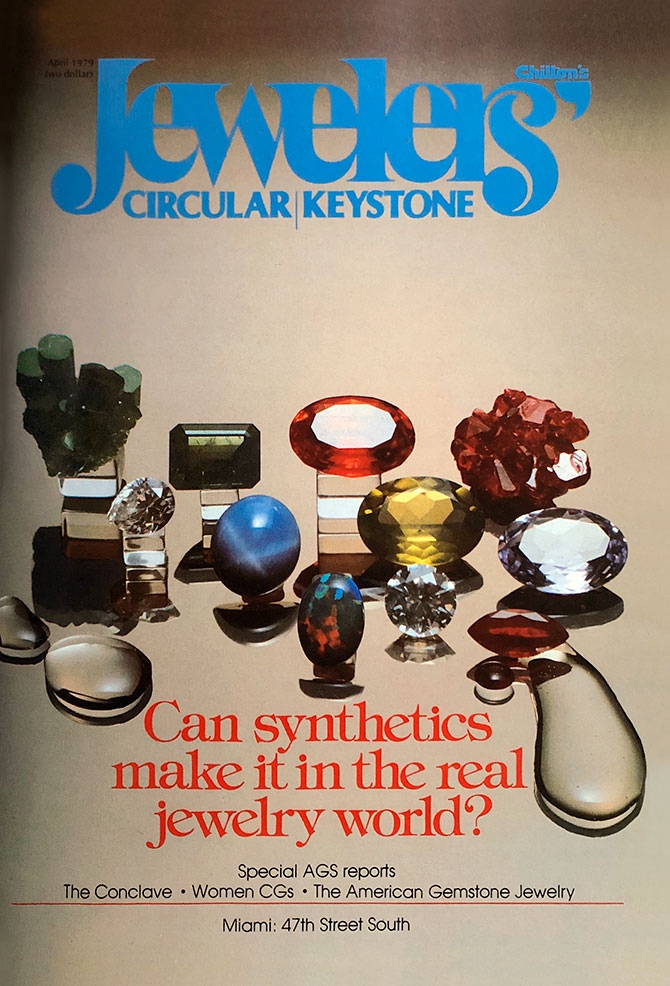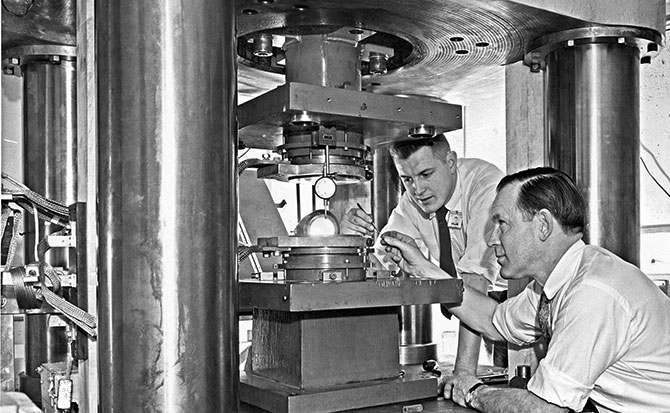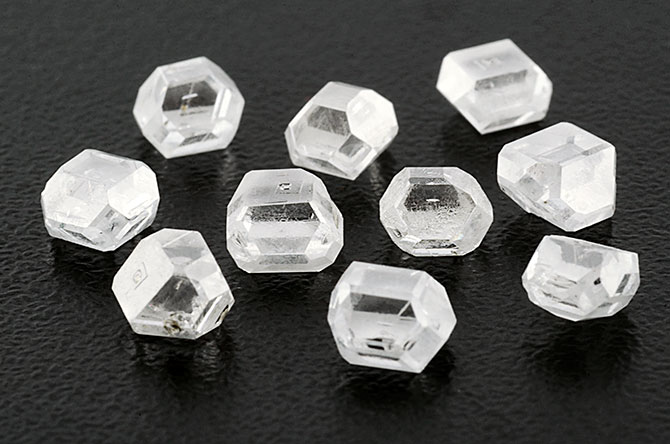Lab-grown diamonds have been a topic of concern for the industry for decades. We chart the paranoia.

How long has the diamond industry been worried about lab-grown diamonds posing a threat to the natural industry? As JCK’s archives show, a long, long time.
1880
Dealers in diamonds are frequently asked by their customers if the process of making artificial diamonds has yet met with such success as to depreciate the genuine ones in value. The London Photographic News gives the following description of the process of manufacture and clearly intimates that there is no danger of genuine diamonds depreciating in value at present.… “The diamonds are, however, of the most minute character, and Mr. Hannay, of Glasgow, who has thus succeeded in making them, frankly owns that the game is not worth the candle.”
—The Jewelers’ Circular and Horological Review, April 1880
1922
Diamonds have been produced synthetically, but the stones made in that way have been so small and have cost so much to produce that there would be no economic advantage in making them large enough to market, even if a way to do it were found. None but Nature ever will produce a clear white crystal at a cost to permit its being marketed.
—New York City jeweler Julius Wodiska, “A Word About Artificial Diamonds,” The Jewelers’ Circular and Horological Review, July 26, 1922
1922
I have noted in many papers, and even in The Jewelers’ Circular, references to the alleged discovery made during the war for the process of making synthetic diamonds in this country (Germany).
We cannot deny the possibility that there may come a time when Nature’s methods of making diamonds will be successfully revealed and imitated in the laboratory, but at best it is only a possibility, and the methods of procedure have brought us no nearer that goal than we have been for 30 years.…
We must realize that all announcements of alleged discoveries in process of development are subject to suspicion, because an intelligent scientist, if he did obtain the secret of making diamonds, would first of all keep it to himself until he put out enough stones to make a fortune. For were he to give out the secret before that time, he would simply make his discovery valueless to the commercial world.
—Alfred Eppler, Ph.D., letter to the editor, The Jewelers’ Circular and Horological Review, Jan. 4, 1922
1936
Dr. J.W. Hershey, McPherson College, Kan., is the 1935 claimant of the title of artificial diamond-maker. He apparently uses a method similar to that of [scientist Henri] Moissan and states the product to be the size of a pin-head.
“Sharpshooters” in London last spring attempted to pass off as a synthetic diamond a synthetic spinel. For a few days, they caused some excitement in the diamond market.
—Sydney H. Ball, “The Diamond Industry in 1935,” The Jewelers’ Circular-Keystone, June 1936

1955
For years, jewelers in their worst nightmares have dreamed that someone would make diamonds in the laboratory and rob them of the mainstay of their business.… There has been a continuous stream of reports, sometimes from Germany, sometimes from France, sometimes from Switzerland, sometimes from Kansas.… [Those reports] faded away in a mist of uncertainty, with nothing ever more heard from them, while the diamond trade has rolled merrily along.…
Now at last it has happened. No intelligent person doubted for a moment that the General Electric company had really succeeded in producing the real thing when their announcement was made late in February.…
The announcement put the diamond trade in a turmoil for several weeks after the initial publicity. General Electric handled the publicity in a way that was calculated to do a minimum amount of damage to the jewelry trade.… They reiterated, over and over, that their diamonds were industrial and they had no present ambitions to make gem stones. It has also been said repeatedly that the cost of their diamonds is in excess of the cost of natural material of comparable quality.
—Fredrick H. Pough, “Synthetic Diamonds: A Threat to the Gem Market?” Jewelers’ Circular-Keystone, April 1955
1970
Man has made cuttable, gem-quality diamonds. The dramatic announcement was made May 28 in New York City by the General Electric Company. Reporters were shown diamond crystals—clear white, blue, and deep yellow, ranging from 60 points to 1.10 carats.…
The jewelers with whom we’ve discussed those stones have not been alarmed. One importer put it this way. “Who should worry? I hear it’s costing GE $5,000 to make a one-carat stone.”
—“First Gem-Quality Synthetic Diamonds ‘Grown’ by General Electric Scientists,” Jewelers’ Circular-Keystone, July 1970

1973
Dr. [Kurt] Nassau closed his talk [at the American Gem Society Conclave] with a question that has nagged many a thoughtful jeweler like a nightmare: Will it continue to be possible to distinguish synthetic gems from the natural?
In reply, he said: “I believe that in the short term, with a sufficiently large effort, one could grow synthetics which would be temporarily indistinguishable from natural gems by present examination techniques. Within a short time, however, new tests would certainly be found to distinguish them, and in the long run the cost to the manufacturer would not be worth the effort.”
Those are comforting words.
—Donald McNeil, “Can Lab-Made Stones Escape Detection?” Jewelers’ Circular-Keystone, May 1973
1990
The new General Electric synthetic diamonds are “beauties,” says a GE researcher who headed the project. More scientifically, they are G and F color and very high clarity, up to flawless. But they are not likely to wind up in diamond dealers’ parcels; they cost more than naturals of comparable quality.
Diamond dealers don’t see any immediate problems.… [They] remember the worries of three years ago when the [synthetic gems from Japanese manufacturer Sumitomo] were introduced.
“Everyone thought the stones would be all over the trade, but nothing happened,” recalls [dealer Joseph] Schlussel.
—Russell Shor, “GE’s New Synthetics are ‘Costly Beauties,’ ” JCK, September 1990
1996
Synthetic diamond jewelry is as predictable as an increase in rough diamond prices. We can predict it will happen, we just don’t know when.…
General Electric, Sumitomo, and De Beers consistently affirm their policies of refraining from selling synthetic diamonds for jewelry use. However, crystal growers in Russia face a different reality: economic survival.…
But will consumers embrace synthetic diamond jewelry? A clear answer emerges from the aftermath of a [Dateline] feature story on this subject: a tidal wave of inquiries to Chatham Created Gems, the San Francisco company involved in a joint venture with the Russian crystal growers.…
As we go about our business as usual, synthetic diamonds begin a tiny trickle into traditional supply channels. Will you be prepared for the first synthetic diamond that crosses your desk?
—Sharon Wakefield, “Synthetic Diamond Jewelry: Are You Prepared?” JCK, March 1996

2003
Typically, synthetic diamonds have been grown using high pressure/high temperature presses. However, synthetic diamonds grown by [chemical vapor deposition] techniques, which do not use high pressure, have up until now produced only microscopic polycrystalline industrial quality crystals.… It’s been assumed that growing single crystals large enough to be faceted would not be possible for years to come.
Apparently, that time is now.
[The] new CVD diamonds, like all other synthetic diamonds, are identifiable. The trade, De Beers, and the consumer, have nothing to fear.
—Gary Roskin, “CVD Synthetic Diamond Is Now Gemmy and -Cuttable,” JCK, August 2003
2010
Some thoughts on Gemesis’ announcement that it is mass-producing colorless gems:
After I posted the story, I received some emails expressing skepticism, reminding me that mass-produced “white” stones have been talked about for some time—in fact, for decades—and are still not seen on the market in any quantity.…
This is a different situation. Gemesis CEO and president Stephen Lux had a nice-sized assortment of beautiful stones that he showed me.… Still, some feel the industry shouldn’t panic until we see the “whites” of their, uh, gems.
Which raises the question: Should the industry even panic? The trade’s main concern is that man-made stones will find their way into the normal stream of commerce without disclosure.… [GIA] has stressed that man-made diamonds are detectable with the proper machines. But most jewelers don’t have that equipment; only the labs do.
—Rob Bates, “Lab Grown Diamonds, in Living Colorless,” JCKonline.com, Nov. 24, 2010